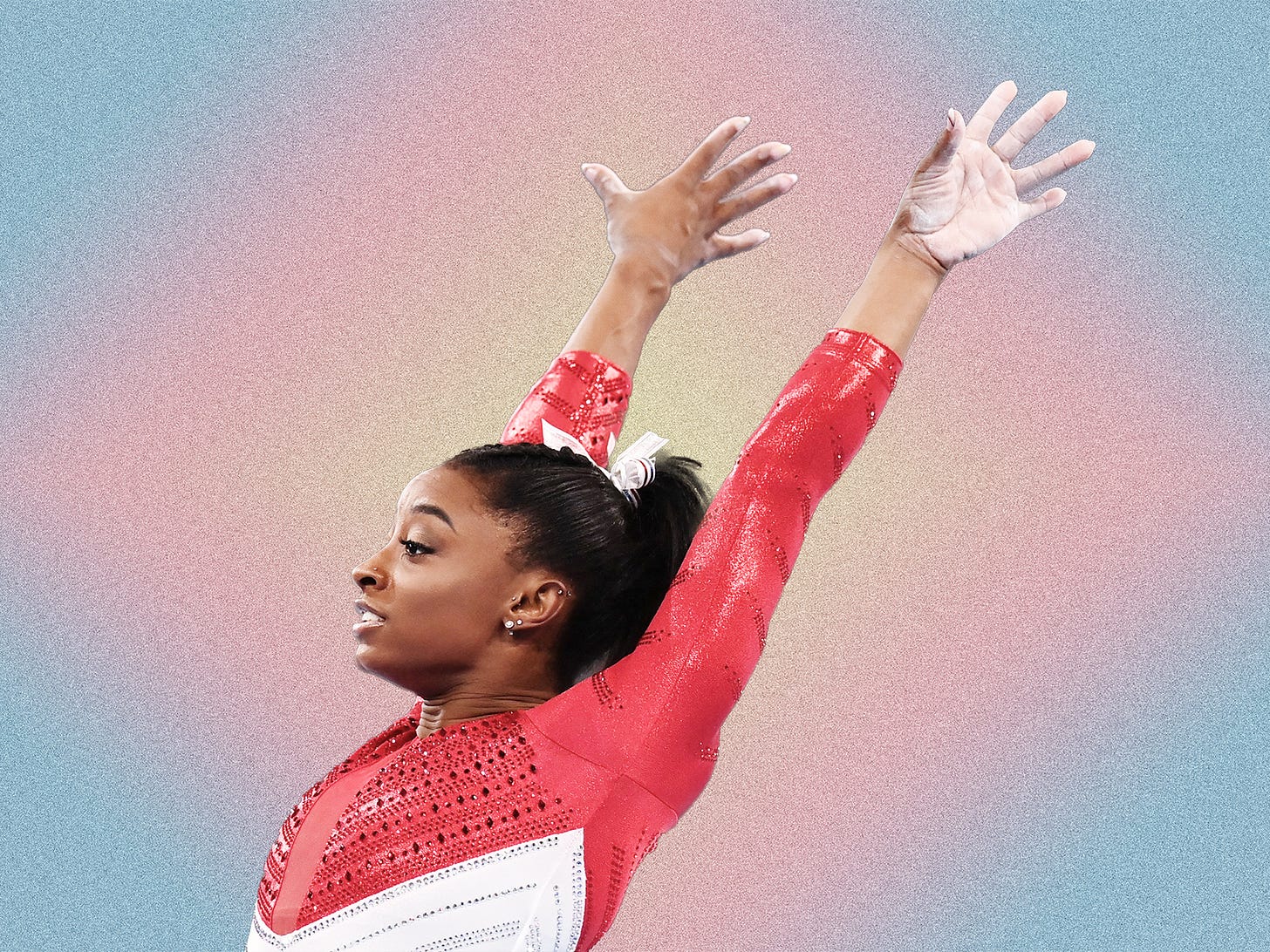
Simone Biles Did Exactly What She Set Out to Do
She didn’t go to Tokyo for herself, but for her fellow gymnasts and for the sport itself.

Simone Biles might not come back from Tokyo with an armful of gold medals, but she still accomplished exactly what she set out to do.
Long before she stepped away from the team finals in Tokyo, the undisputed greatest gymnast of all time stepped away from gymnastics entirely. She took two years off after the 2016 Olympics before deciding to return to competition. So you can’t really understand what happened in Tokyo until you understand what made her come back.
“I knew I had more to give to the sport, for myself,” she said in a pre-Olympic interview:
And I felt like I had a purpose, and now I feel like I do, and that’s to be a voice for the younger generation. And I feel like I’ve done that . . . I just feel like everything that happened, I had to come back to the sport to be a voice, to have change happen. Because I feel like if there weren’t a remaining survivor [of former team doctor and convicted sex offender and child pornographer Larry Nasser] in the sport, they would have just brushed it to the side.
What Biles—and most competitive American gymnasts of the last 40 years—understands is that Nassar and his headline-grabbing crimes were merely a symptom of a larger sickness in the sport. A sickness that started, arguably, when Béla and Márta Károlyi defected from Romania to the United States in 1981, and helped Team USA become an Olympic powerhouse. Over the course of decades of winning gold and glory, the Károlyis changed gymnastics in America, for the worse. They created a culture that teaches little girls that their worth as a person is contingent on their performance on the mat. That encourages athletes to compete on injured limbs in the name of mental toughness. That continues—to this day—to minimize and excuse mental, physical, and sexual abuse perpetrated by those who are supposed to be teaching the athletes and keeping them safe.
Gymnastics, especially for women, is inherently prone to abuse. The physical toll it takes on the body exceeds any other youth sport. Teenage gymnasts get the high-impact traumas common to adult professional football players and the long-term wear and tear that plagues veteran baseball players—all combined with the intense aesthetic physical scrutiny familiar to professional dancers. But gymnasts tend to reach their peak performance when they’re still minors—often 15 or 16, young and impressionable, unsure of themselves as people, and heavily dependent on the care of the adults around them. They have little emotional independence and no financial independence. In many cases, they aren’t even old enough to drive. Is it any wonder Nassar preyed on gymnasts?
Even apart from Nassar, abuse by coaches has become the norm in American gymnastics, not only at the elite level, but for college, high-school, and even younger athletes. USA Gymnastics, the governing body of the sport in America (better known as USAG) keeps a list of coaches who are currently suspended from the sport. Right now it includes more than 70 names. Allegations against those on the list range from forcing athletes to practice on broken bones, to verbal abuse, to sexual assault. Note that this list only includes temporary suspensions—those permanently blacklisted have their own separate list. It runs hundreds of names long. And these are just the most egregious offenders, the ones that USAG was forced to confront. There are many, many more who escape accountability.
That’s why Biles made another run at the Olympics: For the sport. For her fellow gymnasts. Because Larry Nassar’s incarceration didn’t solve the problem. Not even close.
This week, Biles did something I never once considered during my more than a decade as a competitive gymnast: She prioritized her personal well-being over the results of a gymnastics meet. By doing so, she gave thousands of gymnasts at every level across the country and around the world permission to put their welfare first. It was an act of radical courage.
Especially because, for Biles, the stakes were higher than for anyone else. Before the start of the Tokyo Olympics, it was conceivable that Biles could have won five or more gold medals. The kind of sacrifice proportional to that level of achievement is greater than anything a little girl would compete for—but so are the stakes. Every time Biles competes, she risks major injury. Bad gymnastics accidents have resulted in paralysis and even death, and the risks multiply with the power and difficulty of Biles’s skills. That’s why her decision to step back sent such a powerful message: It’s one thing to lose a medal, but quite another to lose a person.
From her public statements, it’s clear that Simone Biles intends to help reform gymnastics and the toxic culture the Károlyis built. I hope she can, because the only alternative is to dismantle the entire industry of competitive gymnastics in America. It’s just not worth it for so many athletes to endure such abuse and danger—even for Olympic gold.
I don’t know if the culture of gymnastics can be reformed. Forty years of injustice would have to be reckoned with, institutions would have to be torn down and rebuilt, and a bunch of bad actors would have to be held to account. In the meantime, the United States might have to get used to not winning so many Olympic medals. A lot of corporations make a lot of money selling the success of our teenage champion gymnasts.
But if there’s anyone who can turn this culture around, it’s Simone Biles. She’s taken an extraordinary first step—not by winning, but by walking away.












